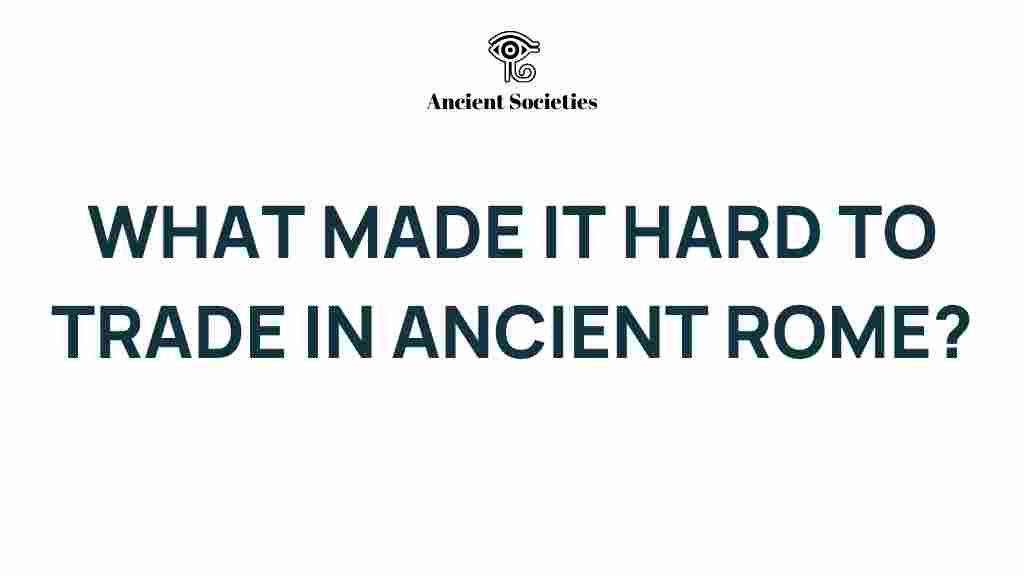Unveiling the Challenges of Trade in Ancient Rome
The economic history of the Roman Empire is a fascinating subject that reveals much about the complexities of commerce during this ancient civilization. While ancient Rome is often celebrated for its impressive architecture and military prowess, the trade obstacles faced by this vast empire significantly influenced its development and sustainability. This article delves into the intricacies of trade in ancient Rome, exploring maritime trade, supply chains, and the cultural exchange that occurred as a result of commerce.
The Landscape of Trade in Ancient Rome
To understand the challenges of trade in ancient Rome, it’s essential to examine the landscape in which it thrived. The Roman Empire stretched across Europe, North Africa, and parts of Asia, creating a vast network of trade routes.
1. The Role of Maritime Trade
Maritime trade was a cornerstone of the Roman economy. The Mediterranean Sea served as a crucial highway for merchants, enabling the flow of goods across vast distances. However, maritime trade also presented its own set of challenges:
- Weather Conditions: Storms and rough seas could delay shipments, leading to shortages of essential goods.
- Piracy: The threat of pirates loomed over merchants, particularly in the Mediterranean, where they could easily ambush ships.
- Navigation Difficulties: Limited navigational tools made it challenging for sailors to determine their positions accurately.
2. Overland Trade Routes
In addition to maritime trade, overland routes were vital for commerce, particularly in regions where sea access was limited. These routes faced their own set of obstacles:
- Terrain Challenges: Mountainous regions and deserts made transport difficult and time-consuming.
- Banditry: Overland traders often faced threats from bandits who sought to rob them of their goods.
- Political Instability: Changing political landscapes could disrupt trade routes and agreements.
Understanding Trade Obstacles in Ancient Rome
The trade obstacles in ancient Rome were multifaceted and often interconnected. Understanding these challenges provides insight into the economic history of the Roman Empire.
1. Economic Factors
The economy of ancient Rome was primarily agrarian, and while agriculture supported local economies, it also created dependencies on grain imports from regions like Egypt and North Africa. This dependency introduced several trade obstacles:
- Supply Chain Vulnerabilities: A poor harvest could lead to increased prices and scarcity of food, impacting urban populations reliant on grain.
- Market Fluctuations: Prices for goods could vary widely based on availability and demand, complicating trade agreements.
2. Legal and Regulatory Challenges
The Roman government implemented various regulations surrounding trade, which, while designed to protect citizens, could also hinder commerce:
- Taxation: Heavy taxes on goods could discourage trade and increase costs for consumers.
- Import/Export Restrictions: Certain goods were subject to restrictions, limiting traders’ ability to operate freely.
3. Cultural Exchange and Trade
Trade in ancient Rome was not only about goods but also cultural exchange. The intersection of different cultures through trade brought both benefits and challenges:
- Language Barriers: Communication issues could arise between traders from different regions.
- Cultural Differences: Distinct customs and practices could lead to misunderstandings and conflicts.
Step-by-Step Process of Ancient Roman Trade
Understanding the trade process in ancient Rome helps to illuminate how these barriers were navigated. Here’s a simplified step-by-step overview of how trade typically occurred:
1. Sourcing Goods
Merchants would source goods from local producers or import them from other regions, often relying on established relationships to secure quality products.
2. Transporting Goods
Goods were then transported via maritime or overland routes, depending on the origin and destination. This stage required careful planning to mitigate risks associated with weather, banditry, and terrain.
3. Market Negotiation
Once goods reached their destination, merchants would negotiate prices with local buyers. This process often involved haggling and could be influenced by market conditions.
4. Distribution
After a sale was made, goods would be distributed to local markets or directly to consumers, completing the trade cycle.
Troubleshooting Trade Obstacles
Merchants in ancient Rome faced numerous challenges, but they developed strategies to mitigate these trade obstacles:
1. Building Networks
Successful traders often built networks with other merchants to share information about risks and opportunities, which helped them navigate the complexities of trade.
2. Diversifying Supply Chains
By sourcing goods from multiple regions, traders reduced their dependency on any single source, allowing them to adapt to shortages or price fluctuations.
3. Utilizing Local Knowledge
Local traders had insights into regional customs and regulations, which could help in avoiding legal pitfalls and enhancing negotiation strategies.
Conclusion
The challenges of trade in ancient Rome were integral to its economic history and the functioning of the Roman Empire. From maritime trade obstacles to the complexities of cultural exchange, the merchants of ancient Rome navigated a landscape filled with risks and opportunities. Understanding these challenges not only sheds light on the past but also informs modern commerce, where supply chains and trade networks continue to shape economies around the world.
For further reading on the economic systems of ancient civilizations, check out this external resource. Additionally, if you’re interested in learning about the influence of trade on contemporary economies, visit our internal link for more insights.
This article is in the category History and created by AncientSocieties Team
